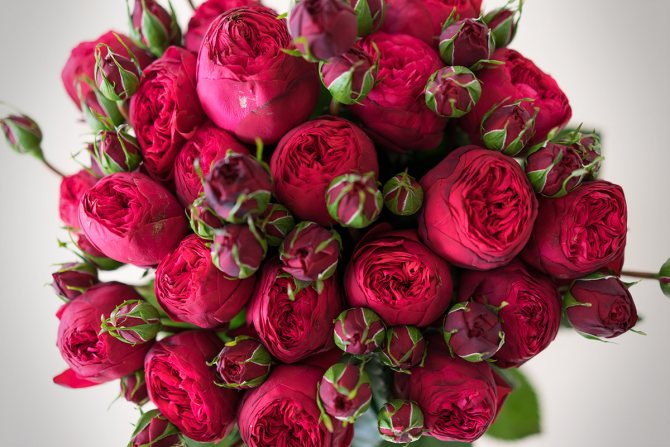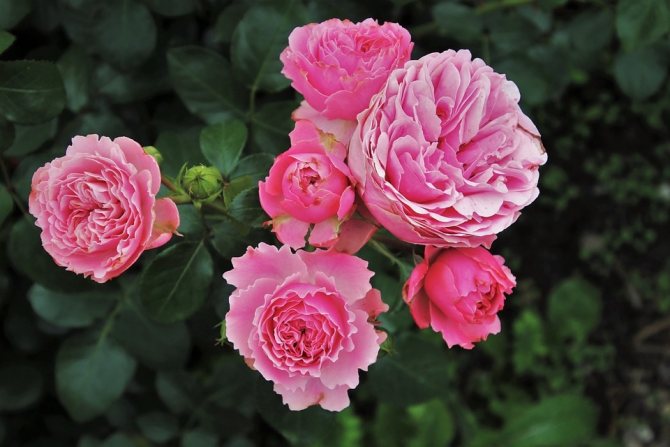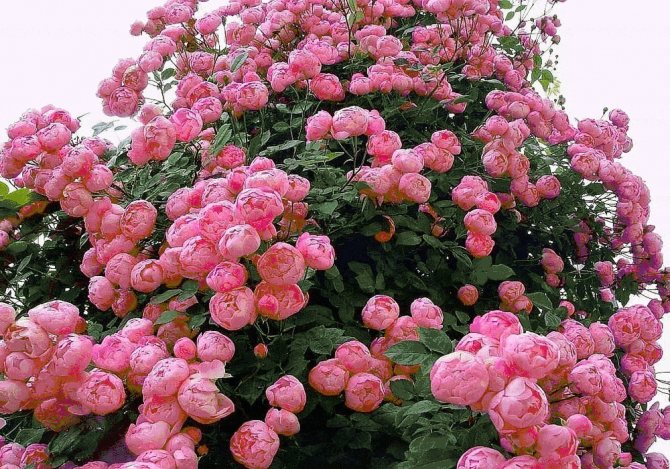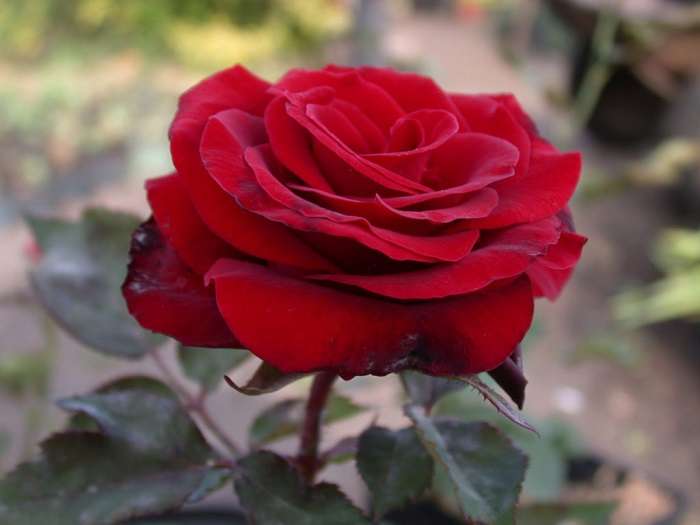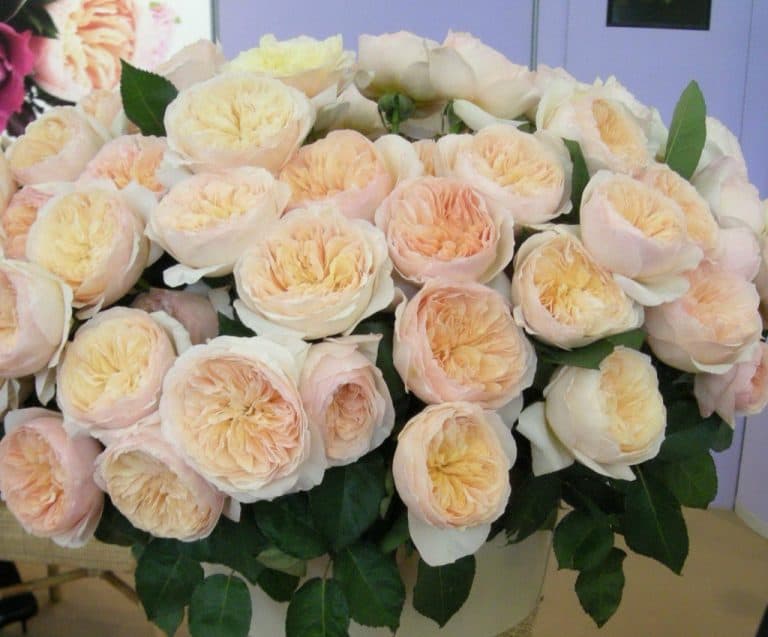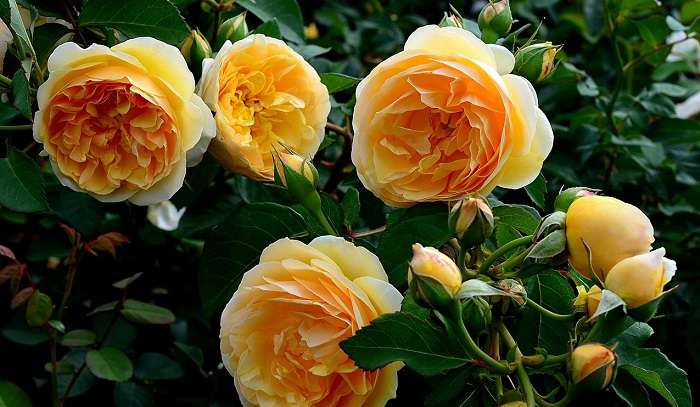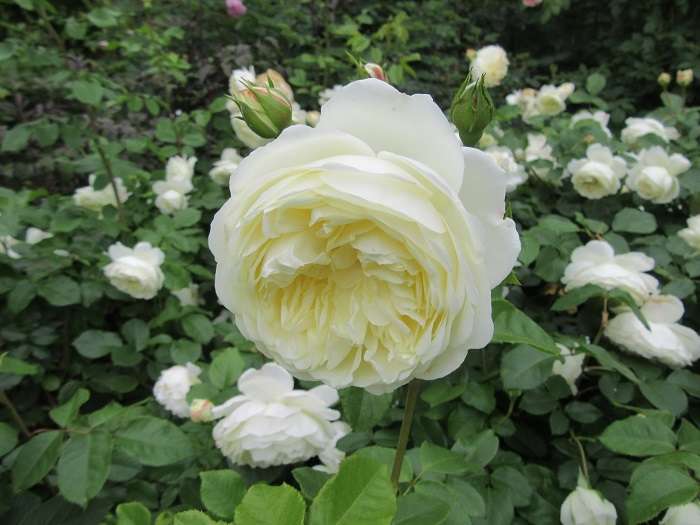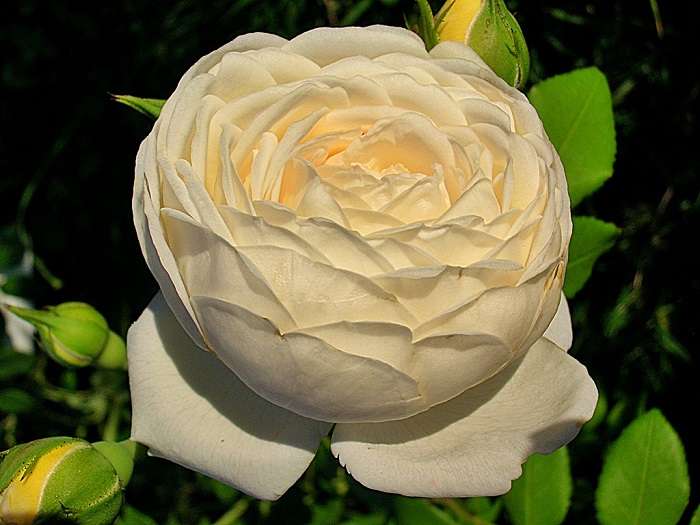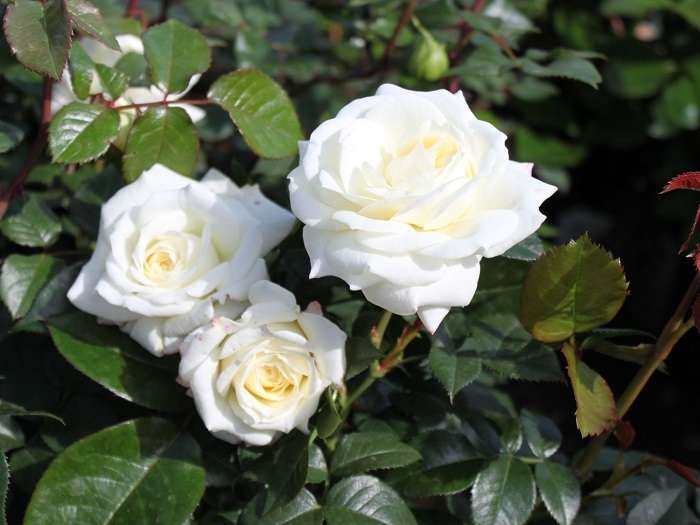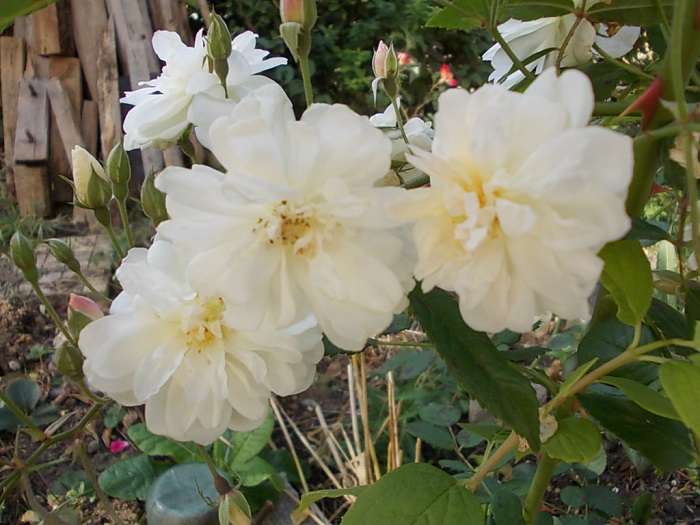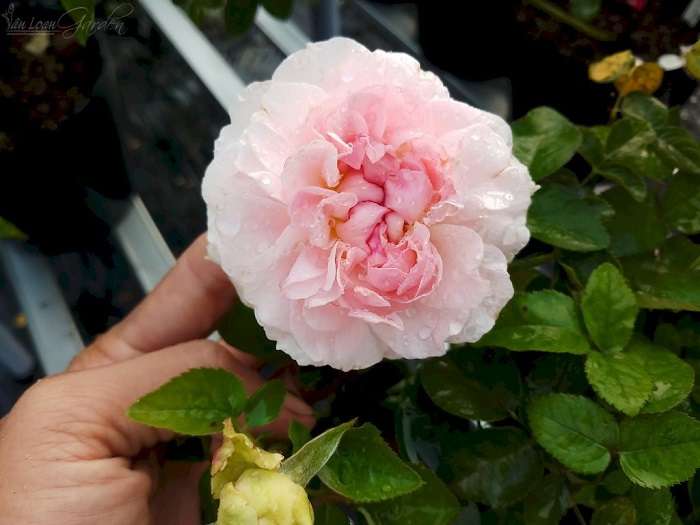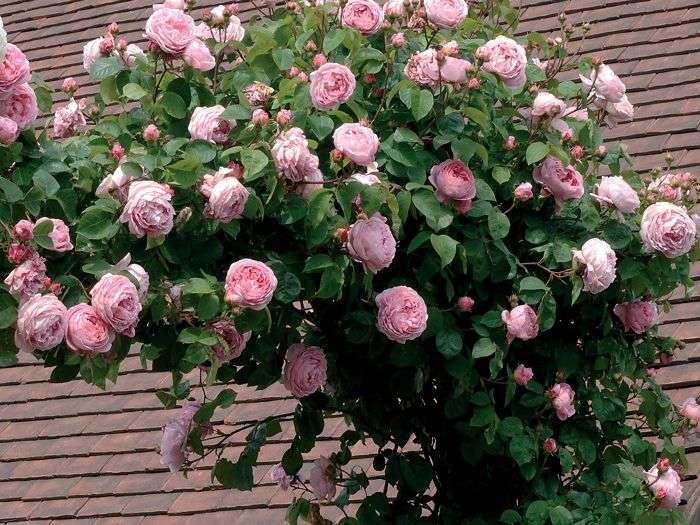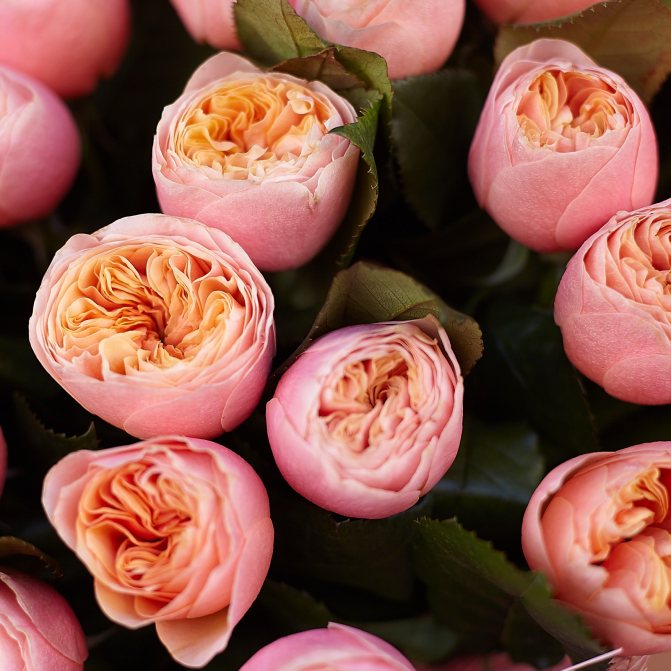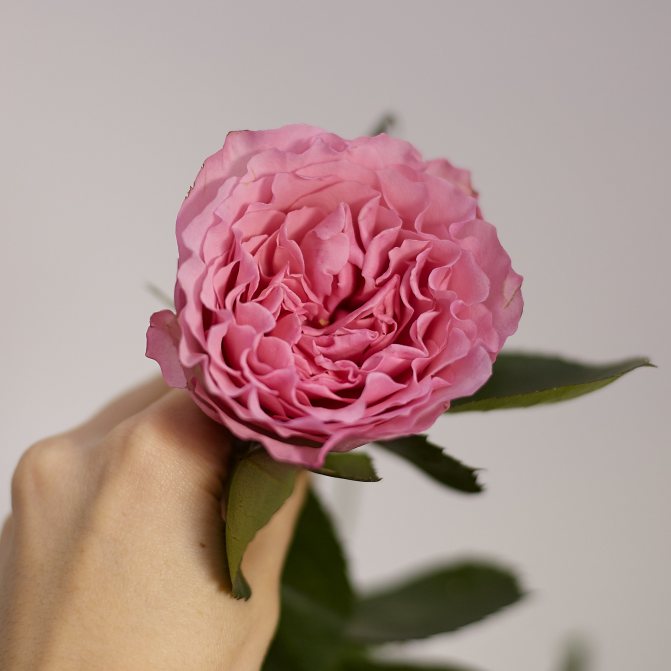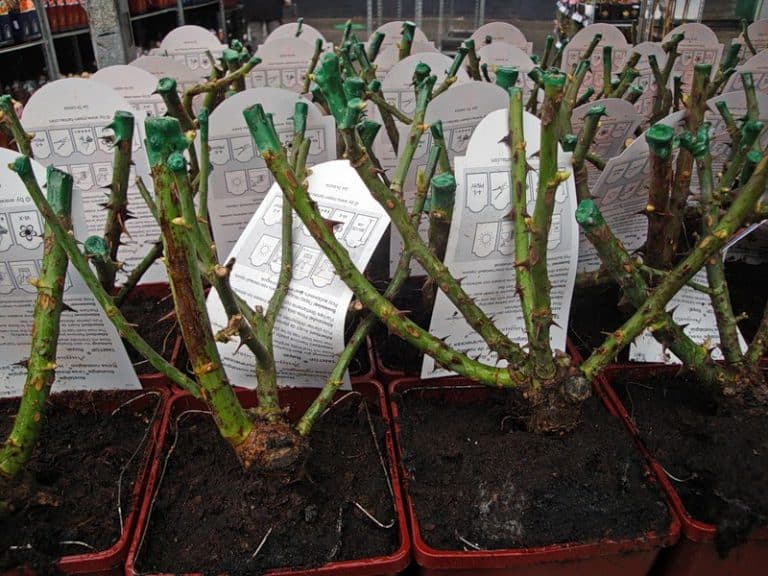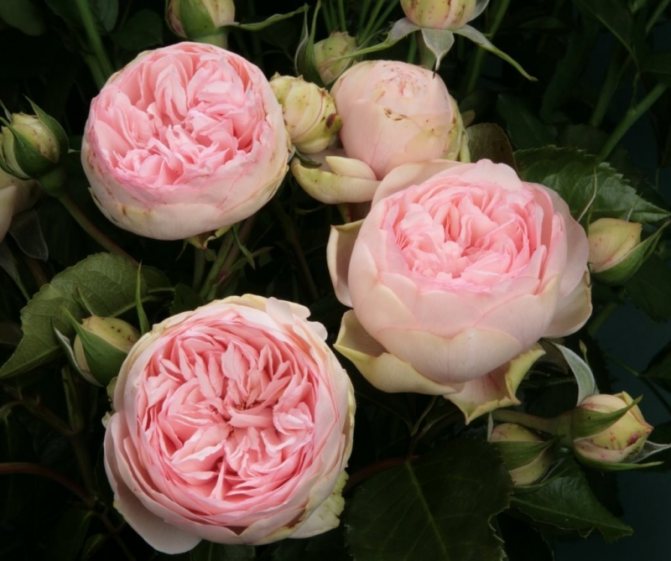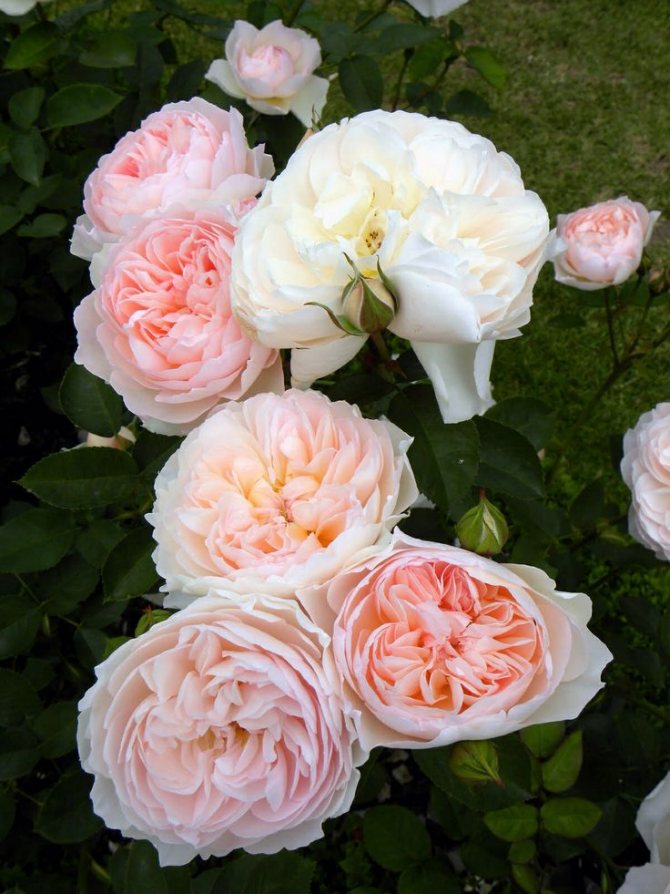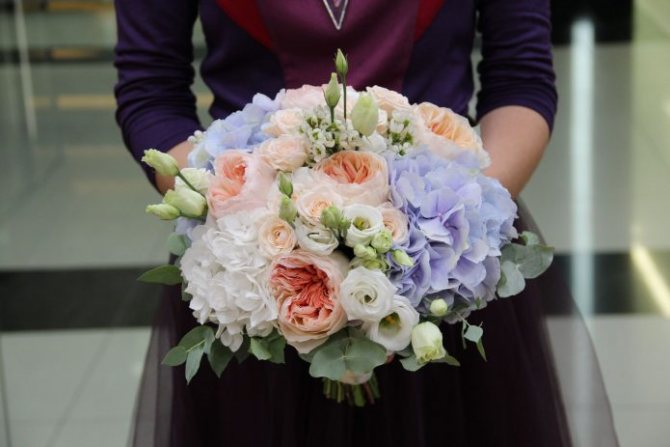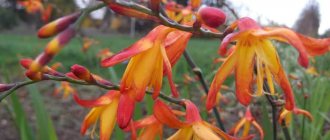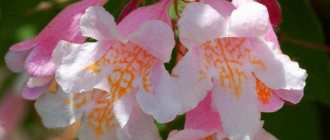What could be more beautiful than an ordinary rose? Of course, the peony rose, which the world became acquainted with at the end of the 20th century thanks to the breeder David Austin. With the shape of peonies and the widest range of colors, this English flower, popularly called "Ostinka", has gained immense popularity among lovers of beauty.
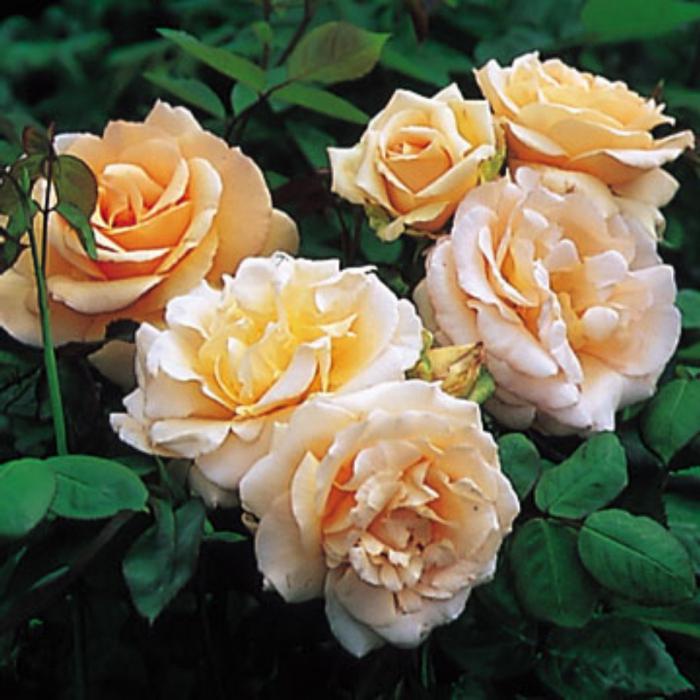
Peony roses are completely picky: do they need constant care, besides? grow fast enough. Despite the fragile charm and pleasant aroma, the bushes are resistant to diseases and unattractive to pests - only for these qualities is it worth to fall in love with such a romantic plant. Like all bush flowers, peony roses form whip shoots and are highly decorative.
Characteristic properties of the plant:
- cupped, pompous or rosette flower shape;
- an amazing aroma, especially intensified in cloudy weather. The most original scent, which can be compared with the scent of French perfume, is characterized by Jude The Obscure;
- the ability to form massive bright thickets.
Varieties of peony roses
To date, there are officially more than 200 varieties of roses. The most popular ones are listed below.
- Constance Spray is the first rose-peony hybrid, characterized by large cupped, pale pink flowers. The bush is vigorous, can reach 4 meters in height, which will be a great idea for launching it on a support, wall or low fence. The plant will be abundantly covered with giant flowers that never fully open. The bush is characterized by small, frequent thorns, as well as pale green, matte foliage.
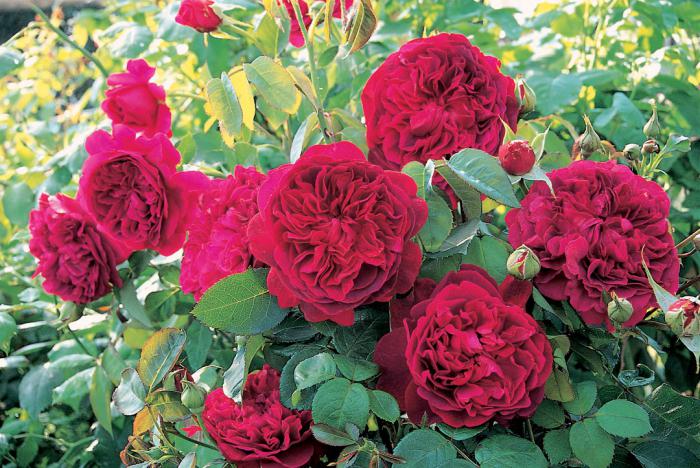

- Pat Austin. The bright copper color of semi-double large flowers is smoothly replaced by a delicate creamy shade. Flowering of this variety occurs early enough, in time for a long time and continuously. The scent is associated with the scent of rose oil. Such a peony rose withstands cold and partial shade well.
- "William Shakespeare 2000". The plant is characterized by peony-shaped flowers, as if divided into 4 parts, with the scent of old roses. The height of the bush is 1.8 meters. It is unpretentious in care, it tolerates shade well.
- Benjamin Britan. The height of beautifully leafy bushes reaches 140 cm (under comfortable conditions - 200 cm). The fruity aroma of crimson flowers, which are about 12 cm in diameter, are pronounced. Densely double, deep, cupped buds are often collected in inflorescences. The bushes, even with a slight flowering, look impressively powerful. The variety, characterized by high resistance to diseases and pests, is recommended for use in flower beds in order to highlight roses of more delicate tones.
- Variety "Othello" is characterized by large double flowers with a rich crimson color, acquiring a purple-lilac hue over time. Moreover, the rose is so dark (especially in cold weather) that it is immediately clear why the variety is called that way. The bush is very thorny, medium in size. Peony roses of the "Othello" variety are collected in a brush, do not droop, which is very good when cut. The bush does not like heat and often blooms again.
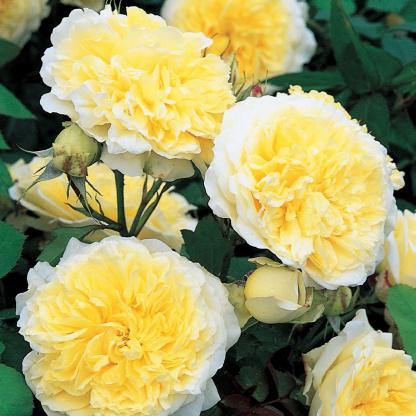

- Austin Gertrude Jackipp is characterized by a tall, strong bush that can be admired in abundance throughout the season (May to November).The scent is associated with the scent of myrrh with hints of old roses. Terry flowers are bright pink, evenly distributed on the bush, covering it from top to bottom. The plant tolerates winter well, is resistant to various diseases. The variety is characterized by optimal fullness of flowering, that is, it fills almost all the space allotted for this. The height of an adult plant reaches 2.5 meters, the girth of the bush is 1 meter.
- Brother Cadfil. Among English roses, this is perhaps the only peony rose that has very large flowers of pink shades. Looks impressive as the center of the composition. Despite the impressive size, the effect of which is enhanced by the petals bent inward, the flowers always look neat, keeping freshness for quite a long time. The variety has a strong, rich rose oil aroma. The bush has practically no thorns and is very proportional. Re-flowering is rare.
Pink hybrids
The most common color for peonies is pink. And Austin roses of the same pink color further emphasize the similarity of these roses to peonies. At the same time, the color saturation depends on the variety, and varies from pale pink, almost peach, to fuchsia. These roses have a large double flower with dense rounded petals. The most famous, one might say, classic varieties of such roses are:
Constance SPRY
Climbing rose of a pale pink shade was bred in England in the 60s of the last century. Its flowers reach 15 cm in diameter, having 5-6 pieces in inflorescences. They bloom from early June to late July and have a very pleasant aroma. The height of this rose can be over 5 m, the bush is strong. strong and spreading. Very spiny small thorns on thick stems. For such a rose, you definitely need a support. By the way, such a rose feels great in a shaded place.
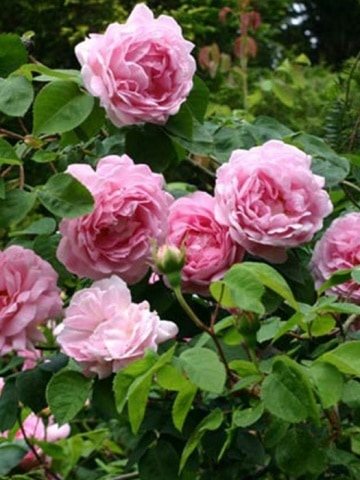

Miranda (MIRANDA)
In 2005, another peony rose variety was bred in England, very reminiscent of Constance Spry. Miranda's flowers are somewhat smaller, about 12 cm in diameter, and have an interesting color that ranges from white to bright pink. The inner petals of the flower are the most brightly colored. The aroma of this rose, although pleasant, is poorly expressed. Such a bush rose blooms twice a summer, and the second bloom lasts almost until the end of October. Flowers are solitary, no inflorescences. The bushes are compact enough, you can grow these roses without support.
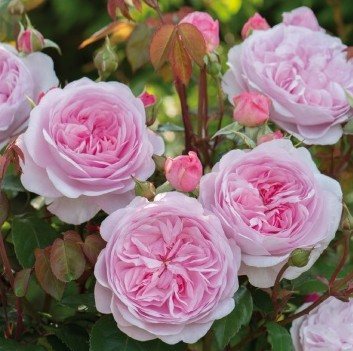

Rosalind (ROZALINDA)
This is another famous peony-like rose variety. Rosalind has rather large single cream-colored flowers that reach a diameter of 12-14 cm. The rose has a very pleasant delicate aroma.
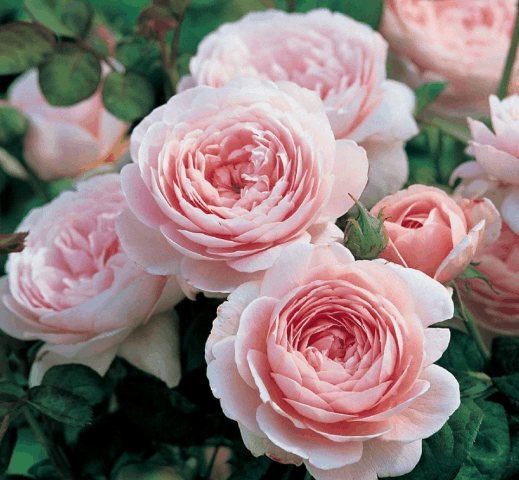

Landing
The high-quality growth and flowering of a rose depends on the correctness of its planting. Well-fertilized soil is one of the important conditions for the successful establishment of a flower. It is better to use horse manure (two centimeters thick), since it does not absorb nitrogen, leaving it in the ground. The planting hole should be made wide (about 1 m in diameter) and deep (about 0.5 m). The smaller size of the hole will not allow the root system of the bush to grow optimally. Fertilizer or compost should be placed in the dug hole. Before planting, the roots of the plant must be treated with a drug that affects the growth rate.
Planting a young plant should be done to a depth of 10 cm, then the flowers will survive even significant frosts. Peony roses are planted in a triangle half a meter apart. This planting scheme creates the impression of dense thickets, which makes it seem that everything around is strewn with roses. For a greater effect of abundance, you need to choose three bushes of the same variety or one growth for planting next to each other. To obtain a beautiful, decorated and fragrant border, it is recommended to plant 1-2 varieties of plants of the same height, which should be alternated during planting.
Many varieties of such roses are shade-tolerant, so they can be safely planted in semi-shaded places. It is important that at least 3 hours a day the peony rose is illuminated by the sun's rays.
Growing and care
Theoretically, caring for a peony rose begins even before it is planted on the site, or rather, at the time of choosing the most suitable territory for the plant. In the future, flower growers should also understand the nuances of watering, feeding, pruning and preparing the plant for wintering.
Optimal conditions and location
Regardless of the color and variety, peony roses can be planted both in single plantings and in combination with other flowers on the site. They are well suited to illuminated and ventilated areas without drafts and possible stagnation of moisture, so it is better to plant rose bushes on a hill - this arrangement prevents rotting of the plant root system.
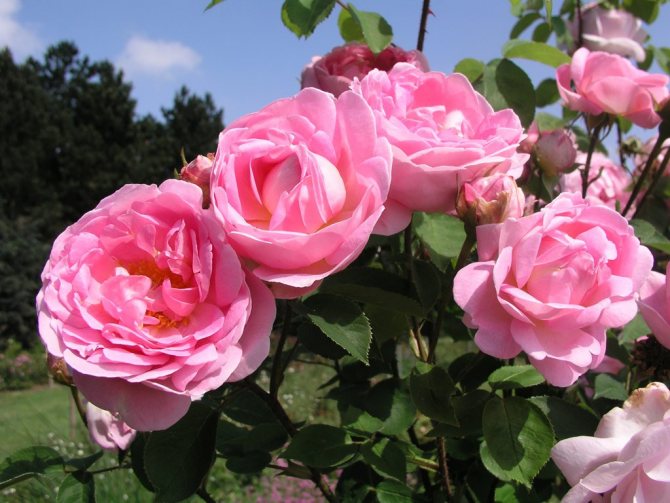

Also, do not forget that these flowers do not tolerate accumulations of nitrogen and limestone in the soil, so it is advisable to choose places with neutral or slightly acidic soil. When planting in low-lying areas, with dense and waterlogged soils, good drainage is a prerequisite for a rose.
Watering and feeding
Watering rose bushes of the described variety should be performed only as needed, that is, when the top layer of the soil dries up. The frequency of this process directly depends on the precipitation, therefore, during the period of prolonged rains, the flowers can not be watered for weeks - drying out the soil is not as dangerous for them as waterlogging.
Also find out why roses can turn black.
On average, 1 adult bush consumes about 5 liters of water - of course, if we are not talking about climbing varieties that consume 10-15 liters. It is advisable to water in the evening, so that under the scorching sunlight the moist earth does not become crusty.
It is possible to fertilize roses only the next year after planting on the site, since until that time the flowers have enough nutrients introduced into the hole during planting.
In the future, with the arrival of spring, the plants should be fed monthly using the following nutrients:
- rotted cow or horse manure, or chicken droppings - dilute in a ratio of 1 cup to 1 bucket of water;
- rotted compost;
- wood ash;
- ready-made mineral fertilizers for roses, bought at any flower shop.
With the arrival of the warm season, nitrogen should prevail in the composition of nutrients, contributing to the growth of green mass. During the formation of buds, its proportion must be reduced, while increasing the concentration of phosphorus and potassium. The introduction of trace elements into the ground should be regular, especially during the growing season.
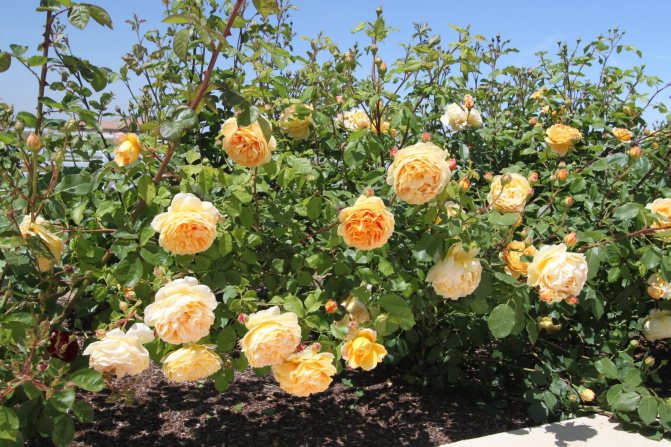

Before flowering, it is advisable to spray rose bushes with a solution of boric acid, for the preparation of which 1 g of the drug should be dissolved in 1 liter of water and stirred thoroughly. Boron is also an excellent bud formation stimulant.
From mid-August until the very cold weather, fertilization of peony roses is no longer needed, since the plants must stop their growth and build up the root system. Remember that shoots that are not lignified before winter can freeze out.
Important! The oversaturation of roses with fertilizers will be indicated by yellowing and curling of leaves on the bushes. If this happens, any feeding will have to be stopped for a while.
Reproduction
Peony roses are propagated in the same way as other varieties of these flowers, that is, by cuttings, layering or grafting. Let's consider each method in more detail.
- The best time for grafting is August, when suitable lignified shoots can already be obtained from adult bushes. It is from them that cuttings with 3 pairs of leaves are cut - however, before planting in the soil, the lower pair should be removed.
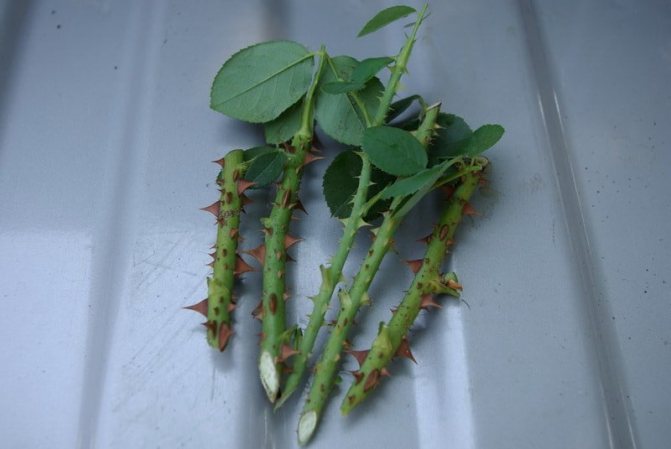

The planting material must be placed on a humus-fertilized area, at a distance of 20 cm from each other, and covered with cut plastic bottles (the cap must be removed from the neck). After planting, the shoots should be watered and then left alone until spring. With the arrival of the first warm days, the cuttings will grow and begin to grow new shoots. If necessary, you can plant cuttings for further cultivation in another territory.
Read more on how to propagate roses by cuttings. - Reproduction by layering carried out in the second half of the summer season, using the long and completely healthy shoots of the mother plant. Having bent the selected part, at its end you need to make a small cut and, fixing the shoot at the soil surface, sprinkle it with soil.
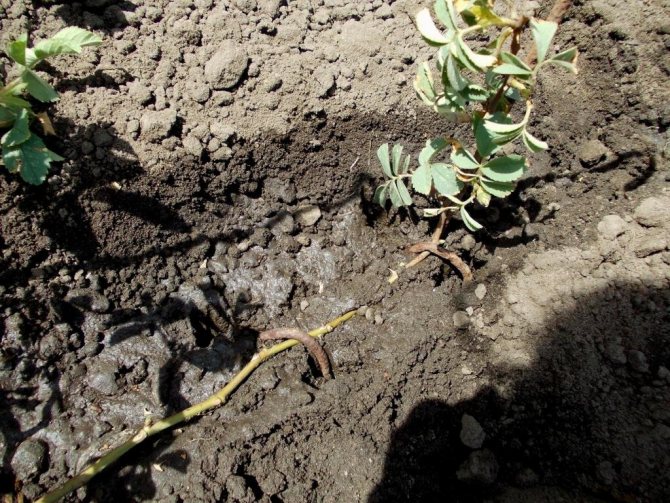

If all actions are performed correctly, a new plant with its own roots will appear from the cut by the next season. It must be separated from the mother bush and planted in the desired place. - Propagation of roses by grafting - the most time-consuming method of all of the above, since it requires precise execution. Its essence lies in performing several simple actions: first, you need to make a T-shaped incision in the bark on the branch, insert a peephole with a bud of the selected rose variety into it, and then fasten them with a soft cloth.
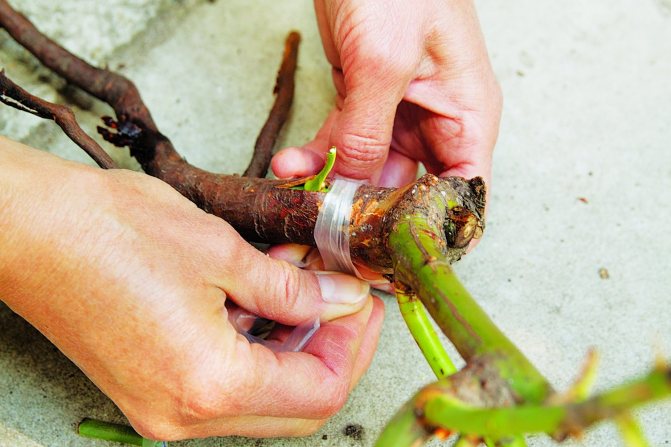

When placed correctly, the grafted part immediately begins to feed from the main bush. Usually, rose bushes are propagated by grafting only in specialized farms, where specially trained people are involved in the procedure.
Pruning and covering roses for the winter
Competent pruning is required for almost every variety of roses, since it not only contributes to the formation of lush buds, but also prevents the development of various ailments associated with thickening of plantings.
For the first time, pruning must be done after removing the shelter: all dried and decayed shoots must be carefully removed from the rose, and healthy branches must be cut off by a third of their length. If the bushes are grown as a living border, then they can be cut to a height of 60 cm.
Important! In the first summer after planting rose seedlings, it is advisable to remove all formed buds from them so that their development does not take away the vitality from the rest of the plant.
In the future, the pruning procedure should be repeated 2 times a year: in spring (for sanitary purposes) and in autumn (in preparation for wintering). In both cases, weak, unhealthy, broken, and sometimes just extra shoots are removed from the bushes so that they do not inhibit the development of the rose.
After pruning in the fall, most varieties of peony roses need to be properly covered for the winter. Having rid the plant of the remaining foliage and cutting off the green and unripe branches, the stems must either first be bent to the ground and secured, or immediately covered with a layer of sawdust and straw, if necessary, additionally covering them with spruce branches, plastic caps or non-woven material.
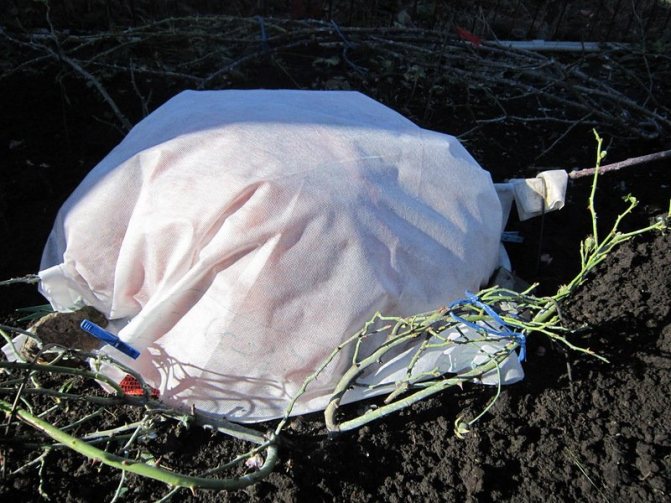

It is advisable to cover the flowers until the temperature drops to –2… –5 ° С, since the frozen roses do not bloom so actively in the future, if they can survive the winter at all. You can also make a shelter from wooden or plastic arcs, with dense agrofibre fixed to them, or cover the plants with special cover-houses, which are easy to find in flower shops. You can remove the shelter when the temperature stabilizes at 0 ° C, after which it is also worth removing the layer of mulch from the root system.
We recommend that you find out the basic rules for pruning roses for the winter.
Features of the flowering period
Almost all varieties of peony roses are characterized by an early onset of flowering, and some of them bloom twice during the summer.Of course, the second time the flowers will not be so large, but the bush will have time to fully ripen before the onset of cold weather, which in the future will greatly facilitate preparation for winter.
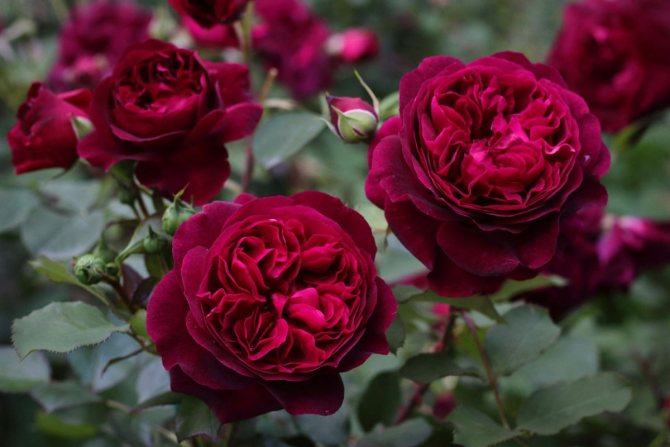

The disadvantage of peony varieties in terms of flowering is the high sensitivity of flowers to high humidity, which often leads to decay of the buds. In addition, summer heat affects them not in the best way, because of which the flowers become smaller, and the flowering period is almost halved.
On the site, varieties of Canadian and English roses also delight with their flowering.
Watering and feeding
Top dressing of peony roses is required in the spring; in June, the flowers need to be fed with nitrogen fertilizers. During the budding period, the soil should be enriched with calcium-phosphorus fertilizers. It is recommended to stop feeding the plant at the end of August. The proportions must be observed strictly according to the norm, otherwise the oversaturation with fertilizers will negatively affect the plant: the leaves will begin to turn yellow and fall off.
It is recommended to water the flowers in the evening as the soil dries up, in which case the moisture does not evaporate. Water consumption per bush is approximately 12-15 liters.
Flower characteristic
Distinctive features of a peony rose:
- Flower shape in the form of a bowl or pump.
- A chic aroma that intensifies in cloudy weather. Some flowers smell like French perfume
- Bushes of this type of roses can form dense thickets.
Garden lovers love these bush plants for their fast growth and lack of daily care. Also the huge advantage of these flowers is disease resistance and lack of attractiveness to pests.
Features of pruning rose bushes
Pruning the bush should be done before bud break, removing weak and old shoots. In this case, the branches must be cut by a third. Depending on the imagination of the grower, the bush can be given a non-standard shape. In October, you need to cut off ripe shoots and leaves. When growing roses in a curb version, they must be pruned to an approximate height of 0.6 meters. The first wave of flowering will take place at the same level, the second and subsequent ones - at different levels, because young shoots will begin to grow actively, exceed the specified height, thereby violating the desired harmony.
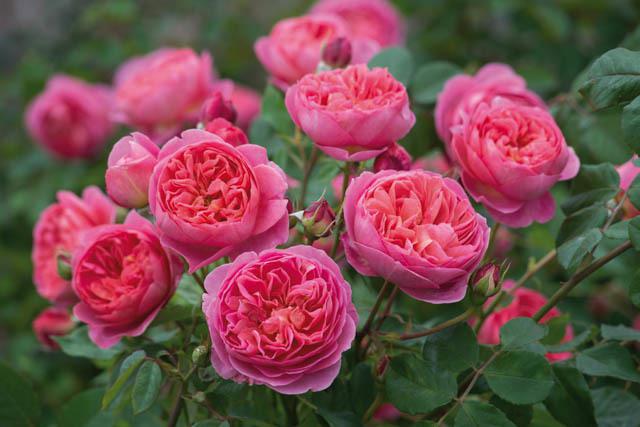

Pre-winter preparation includes bending the stems to the ground, then fixing them, covering them with soil, sawdust or foliage. Straw can be placed on top to keep warm. It is not recommended to use the film as a covering material due to the lack of air access.
Highlights of further care
David Austin's English roses after planting do not differ in special care. You should monitor the moisture content of the soil, weed out and loosen it regularly. During this procedure, it is better to act carefully so as not to damage the root system. Watering is best done with warm, settled water directly under the root. The frequency of watering depends on the weather conditions, but when growing Austin roses, a strict rule applies: it is better to underfill than overflow.
Fertilization of plants is carried out in the second year after planting. This is done with the onset of spring every three to four weeks. During the period of active growth, nitrogen fertilizers are used. Before bud formation and during flowering, the plant needs phosphorus and potassium.
The following mixtures can be used as fertilizers:
- Over-matured compost.
- Diluted and fermented cow dung.
- Chicken droppings infused in water and diluted 1:25.
- Wood ash.
- Bone flour.
- Purchased mineral mixtures.
- Folk recipes for feeding roses.
Top dressing is stopped in mid-August so that the plant is prepared for wintering, and not start active growth of shoots.In the fall, sanitary and shaping pruning of the bushes is carried out, and the cuttings obtained can be saved until spring for further rooting.
You may be interested in: Spring garlic, planting and care in the open field, feeding, pest control
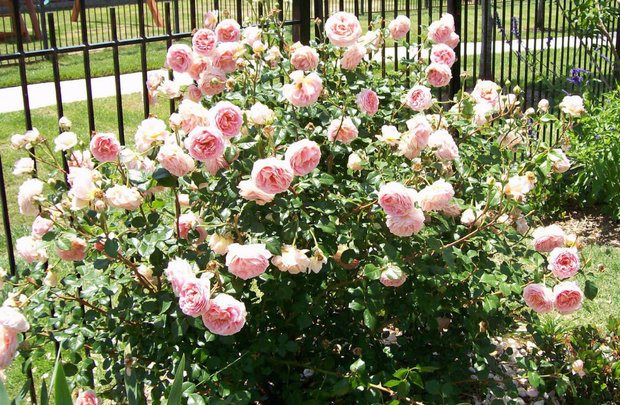

Advantages and disadvantages of peony roses
Early flowering is a characteristic for which peony roses are prized. The photo fully conveys all the beauty of their flowering, which ends in June. After this, the formation of new young shoots occurs, which determine the re-flowering of the bush in August-September.
The disadvantages of ostins are their high sensitivity to excess moisture and precipitation, a large amount of which during the flowering period can lead to decay of flowers. They may simply not have enough strength to open the bud. High temperatures can lead to crumbling flowers, discoloration of the petals and a shorter flowering period.
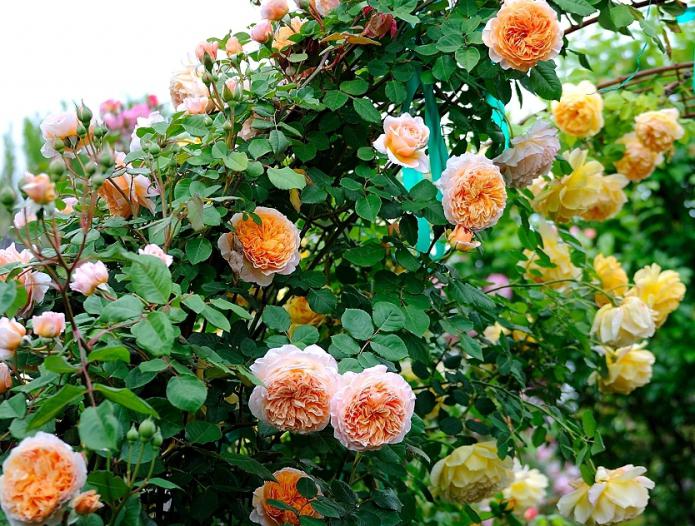

Cutting, the formation of layers or seeds are the ways in which peony roses propagate. Seedlings are accepted quickly enough, and in a year a new young bush will delight with its gorgeous flowering.
Disease prevention
Despite the outstanding appearance, Ostinka roses do not differ in strong immunity. Under favorable growing conditions, this quality does not greatly interfere with enjoying the magnificent buds, but in the harsh realities of life, the bushes can die in a matter of weeks.
To prevent characteristic diseases, preventive and therapeutic spraying is performed. You can use a weak solution of copper sulfate, milk whey and dusting with wood ash. At the same time, when you find the first signs of black spot or powdery mildew, it is best to buy a special chemical preparation, because the rate of spread of this "infection" is very high.
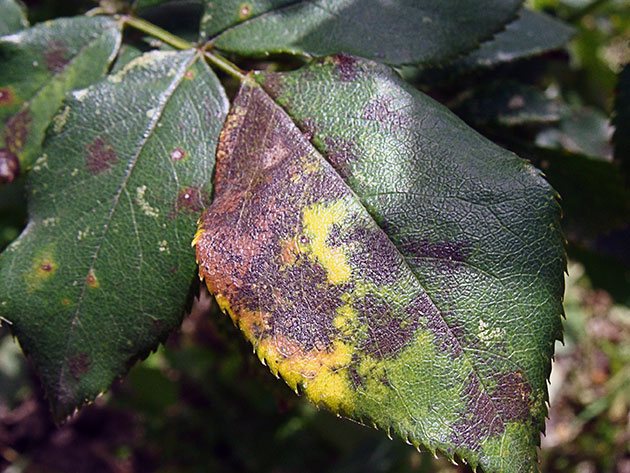

In total, it is advisable to carry out three preventive measures during the season. The first spraying is carried out in late April - early May, when the first leaves appear. The second time the bushes are treated before the start of mass flowering. The third treatment is more dependent on weather conditions. The development of fungal diseases most often occurs in the second half of summer with prolonged rains and cold snaps at night.
You may be interested in: Japanese gladiolus, planting and care: recommendations
For the procedure, it is best to choose a cloudy day, but no precipitation. For normal absorption of substances into the leaves, five to six hours are enough, therefore, if the rain passes earlier, the procedure must be repeated.


